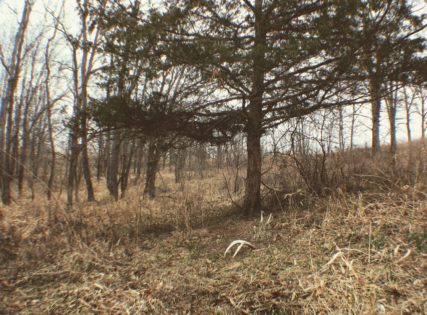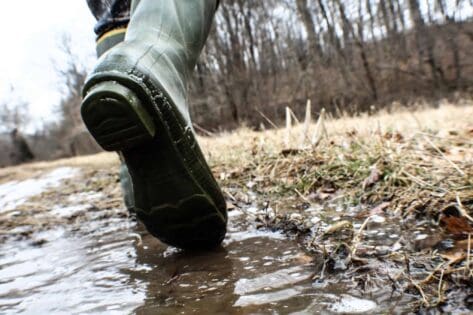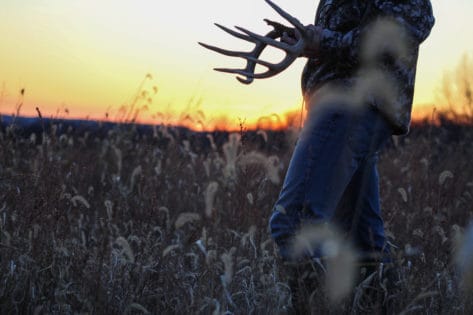 Finding a match set of sheds can be a difficult task to say the least. Bucks can be one sided for multiple days allowing them to drop their antlers literally miles apart. However, the majority of bucks if left undisturbed, will stay within a distinguished late season pattern as long as cover and a quality food source persist throughout winter. That being said, most deer will not shed their antlers side by side, rather they will drop their antlers some distance from each other. Once you have found one side of a particular buck, the next challenge finding the other side. I’ve compiled a short list of tactics I use to try and find match sets of antlers here in the Midwest.
Finding a match set of sheds can be a difficult task to say the least. Bucks can be one sided for multiple days allowing them to drop their antlers literally miles apart. However, the majority of bucks if left undisturbed, will stay within a distinguished late season pattern as long as cover and a quality food source persist throughout winter. That being said, most deer will not shed their antlers side by side, rather they will drop their antlers some distance from each other. Once you have found one side of a particular buck, the next challenge finding the other side. I’ve compiled a short list of tactics I use to try and find match sets of antlers here in the Midwest.
Where to Look for the Other Shed Antler
After you find the first shed antler, take a step back and evaluate what the buck was doing at that time and why he would be there in the first place. Basically, you can narrow it down to a few different locations in late winter; bedding, food source, or traveling from bed to food.
Shed in a Bed? Search the Surrounding Cover…
If I find the first shed in bedding cover, or in an actual bed, I’ll start by taking note in which way the bed was facing, this can lend you an important clue for why and when the buck was there. For instance, if the bed is laying from West to East on a southern exposure, it probably means that that buck was bedding there during the daylight soaking up the extra sunlight. Be sure to scour the surrounding area as bucks will tend to get up and browse throughout the day on woody vegetation nearby and will often knock the other side off while browsing. If I’m unsuccessful at finding the other side nearby in surrounding cover, I’ll focus the next part of search to the closest food source. In the Midwest this typically means some type of agricultural field or food plot.
Determine the Closest Quality Food Source
Food source is obviously key for the buck being there in the first place. If for instance you found the first shed antler in a bedding area, locate the primary trails leading to the most prominent food source nearby. Make sure to cover each trail, typically there are two to three good trails leading directly to the food source. In years of heavy snow and extreme cold, deer will make a direct line from their bedding to food. When we have a more mild winter, whitetails are less keen to take the same route day after day and can make for locating the other side more challenging.
Once you cover the trails that lead to the food source, depending on the size and cover around the food source, this will probably be your best bet at finding the other side of the buck. Focus on the edges in agriculture fields. Especially the south side of fence lines or any type of structure a buck might be able to take cover from strong northerly or westerly winds. Also check drainages and waterways in larger food sources where bucks tend to bed down during their overnight feeding hours.
Broaden the Search Area- Search in “Classic” Shedding Spots
If you are unable to find the match in the primary food source in the area, broaden your search. It’s not uncommon to find the other side ¼ mile away or further from each other. If you’re trying to find the other side to a very big buck and have ample time to do so, take a topo map of your hunting area and use the process of elimination. Eliminate all areas in which you believe least likely for the buck to have dropped the other side. Highlight areas in which you believe the best opportunity to find the other side and focus your search in those areas.
A few years back, my oldest brother and I were out shed hunting in Central-Indiana. We often bring walkie talkies and cover wide traverses of land at a time. I was surprised to hear my brothers excited voice over the radio just an hour or so into our search about finding a monstrous 4-point side in a swampy area we frequently find sheds in. The search/race was on for the other side.  That year, the surrounding fields were planted entirely in corn which engulfed the 150-acre block of timber. Narrowing down the places the buck could feed seemed almost impossible. We first scoured the nearby area without luck and then broadened the search for the other side. We looked for about 8 hours without any luck. The following day, my brother went back to the area again and spent half the morning looking. He was walking back to the truck when he decided to check a wood line that was close to a mile away from where he had found the first antler. To his great surprise, he found the antler lying next to a bed along the fencerows grassy edge.
That year, the surrounding fields were planted entirely in corn which engulfed the 150-acre block of timber. Narrowing down the places the buck could feed seemed almost impossible. We first scoured the nearby area without luck and then broadened the search for the other side. We looked for about 8 hours without any luck. The following day, my brother went back to the area again and spent half the morning looking. He was walking back to the truck when he decided to check a wood line that was close to a mile away from where he had found the first antler. To his great surprise, he found the antler lying next to a bed along the fencerows grassy edge.
In the end, you may never find the match set but if you keep a positive attitude and continue to diligently search for the other side your chances for matching up the other side can only increase. When you do find the other side, the effort will be well worth it.
-Zach Jumps
Zach@HeartlandLodge.com
Last Updated: February 21st, 2022











































